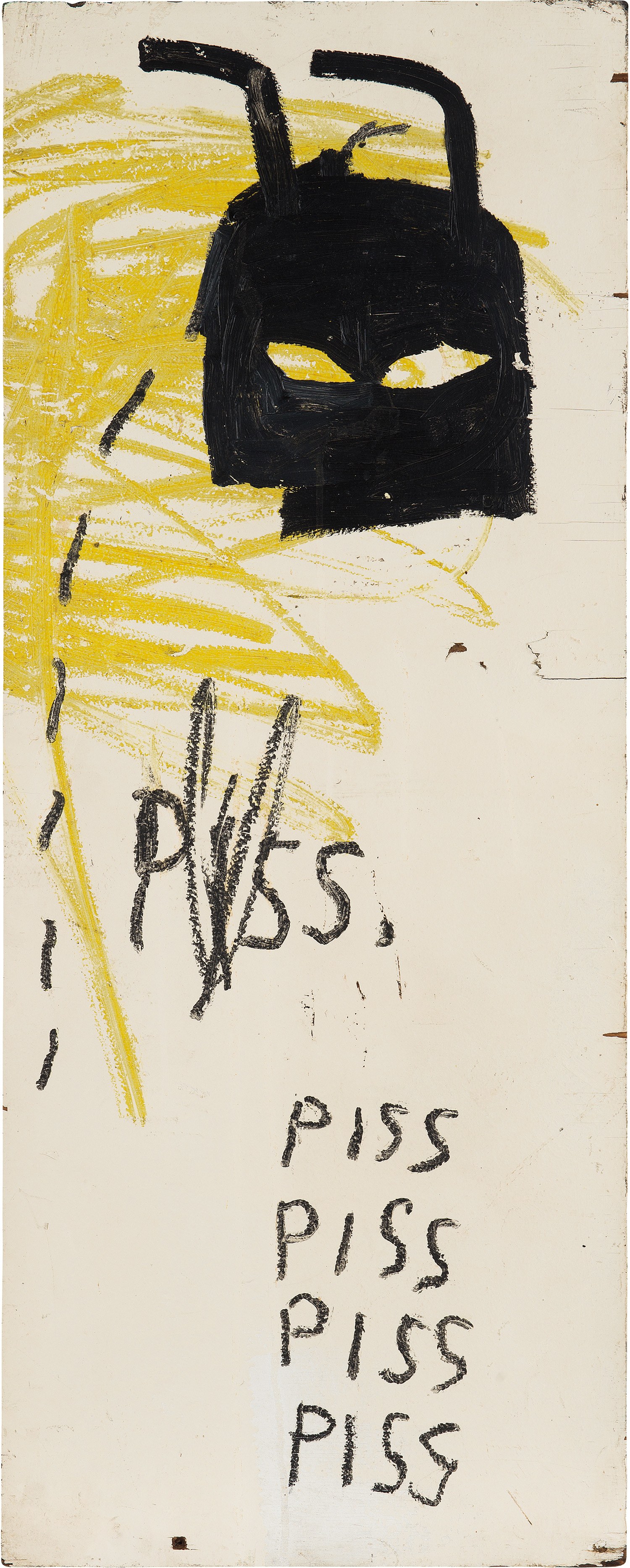

37
Jean-Michel Basquiat
Untitled (Piss Piss Piss Piss)
Full-Cataloguing
With its graphic insistency and explicit subject, this is a painting with the confrontational immediacy of graffiti. Graffiti provided a key artistic means for Basquiat, who first gained the attention of the art world in the late 1970s for the conceptually and politically charged works that he spray-painted around downtown Manhattan in collaboration with his friend Al Diaz under the tag SAMO©. Moving to painted, drawn, and multimedia work by late 1980, Basquiat retained and expanded his striking use of writing and his improvisational approach. As Klaus Kertess stated, Basquiat was motivated by “a pure voracity for words, a reveling in the vernacular, and a desire to reinvent and claim language” (Klaus Kertess, “Brushes with Beatitude”, in Jean-Michel Basquiat, exh. cat., Whitney Museum of American Art, New York, 1992, p. 53). Often repeating words in columns, crossing them out, and painting over them, he retained their verbal and allusive content while employing them as key compositional elements.
Basquiat combined street vernacular with a style inspired in part by the balance of crudity and sophistication pioneered by Cy Twombly. Twombly’s 1979 retrospective at the Whitney Museum of American Art had a great impact on him, with the artist revealing in a 1983 interview that his favorite work by Twombly was Apollo and The Artist, 1975. As Richard D. Marshall has noted, “from Twombly, Basquiat took license and instruction about how to draw, scribble, write, collage, and paint simultaneously” (Richard D. Marshall, Jean-Michel Basquiat, Paris, 2000, p. 40). The present painting echoes Twombly’s style in its incorporation of language and gesture, strategies that Basquiat made his own and combined with expressive figuration.
The themes of Untitled (Piss Piss Piss Piss) also recall those of Andy Warhol’s Oxidation Paintings – known casually as the Piss Paintings – and highlight Basquiat’s history with the Pop artist. Warhol created most of these works in 1977 and 1978, painting canvases with copper pigment, laying them on the floor, and inviting his Factory members to urinate on them. This process transformed their surfaces to areas of black or green through a chemical reaction, in a transgressive parody of Abstract Expressionism. The Oxidation Paintings are abstract, with a prominent exception that is key to understanding the present work. When Basquiat visited Warhol’s studio in October of 1982 with Swiss dealer Bruno Bischofberger, Warhol took Polaroids of the younger artist, silk-screening them onto 40-by-40-inch canvases that had been covered with cooper paint, then creating three Oxidation Paintings featuring Basquiat’s image. Produced before the later collaborations by the two artists in the mid-1980s, these portraits are unique in Warhol’s oeuvre. As Neil Printz speculates, “Precisely why Warhol chose to revive a technique from four years before as a background for Basquiat’s portraits is not clear—possibly Basquiat suggested it, or perhaps Warhol was drawn to the idea by the way the surface wed associations with the precious and abject” (Neil Printz, The Andy Warhol Catalogue Raisonné: Paintings, 1976-1978, vol. 5B, London, 2018, p. 132). Therefore, it is interesting to consider the present work as a painterly response to, or perhaps even an inspiration for, Warhol’s extraordinary portraits of Basquiat.
With its black color and oblong slits in the place of eyes, the head on the painting’s top suggests a mask, evoking themes of both anonymity and assumed character. In addition, Basquiat’s heads and masks played off the abstract forms of African art and their interpretations by modernist painters. For this young African American painter, this motif constituted both an expressive subject and an assertion of his identity. As Marc Meyer has noted about Basquiat, “many of his works maintain a sub-textual argument with his predecessors, full of corrections, challenges, homages and some spectacular showing off” (Marc Meyer, “Basquiat in History” in Basquiat, exh. cat., Brooklyn Museum, New York, 2005, p. 44). These themes, in conjunction with this unique painting’s confrontational subject and tone, convey the complexity of Basquiat’s work and his negotiation of his artistic self through it.
Jean-Michel Basquiat
American | B. 1960 D. 1988One of the most famous American artists of all time, Jean-Michel Basquiat first gained notoriety as a subversive graffiti-artist and street poet in the late 1970s. Operating under the pseudonym SAMO, he emblazoned the abandoned walls of the city with his unique blend of enigmatic symbols, icons and aphorisms. A voracious autodidact, by 1980, at 22-years of age, Basquiat began to direct his extraordinary talent towards painting and drawing. His powerful works brilliantly captured the zeitgeist of the 1980s New York underground scene and catapulted Basquiat on a dizzying meteoric ascent to international stardom that would only be put to a halt by his untimely death in 1988.
Basquiat's iconoclastic oeuvre revolves around the human figure. Exploiting the creative potential of free association and past experience, he created deeply personal, often autobiographical, images by drawing liberally from such disparate fields as urban street culture, music, poetry, Christian iconography, African-American and Aztec cultural histories and a broad range of art historical sources.